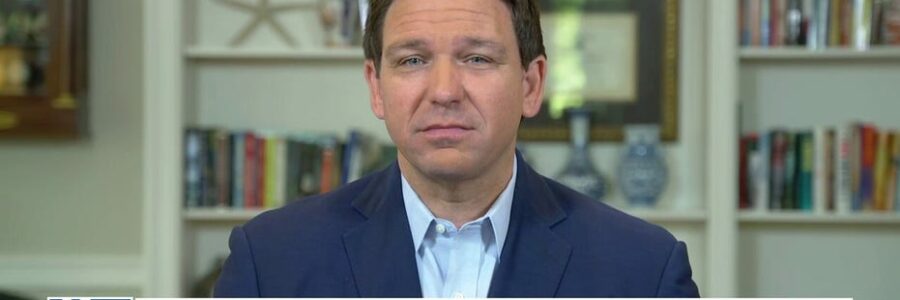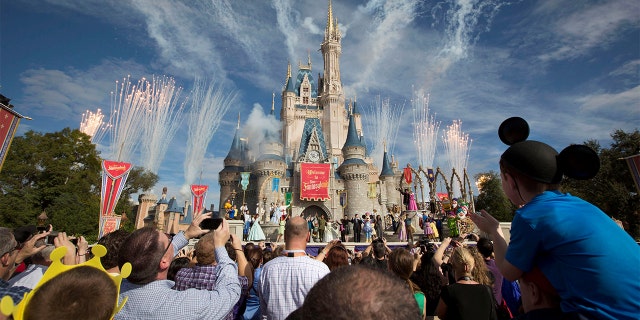
Woke Disney vs. Walt's Disney: Is political corporate model sustainable or just goofy?
Florida revoking Disney’s self-governing status marks ‘major shift’ for state: Gov. DeSantis
Florida Gov. Ron DeSantis says the state views Disney’s attempt to impose ‘woke ideology’ as a significant threat.
There is no company or brand more associated with American childhood than Disney. For nearly a century, throughout all the social and cultural shifts, Disney has held a mirror up to the experience of growing up in this country.
Today, controversy has crashed into this symbiosis over Florida’s education bill that bars teaching about sexual orientation or gender identity in kindergarten through third grade. Can Disney take a firm stand on this issue and remain the storyteller to America’s kids?
Fireworks go off around Cinderella’s castle during the grand opening ceremony for Walt Disney World’s Fantasyland in Lake Buena Vista, Florida, Dec. 6, 2012.
(Reuters/Scott Audette/File Photo)
To answer this question we have to look at where Disney is today, and how it arrived here, especially in terms of how it deals with questions of transgender ideology and homosexuality. The executives, as seems to be the case in most major corporations today, are eager to say that they are making the company better in terms of diversity. But better than what?
Over the weekend I spent a few days at Disney World, the physical manifestation of the company’s brand and oeuvre. Despite the Sturm und Drang over the company’s wokeness, on the ground, little of these new progressive ideas are visible. Disney World has not become the East Village.
Despite the fever dreams of the diversity team, recently exposed on a Zoom call demanding more non-binary characters, at the resort little girls are still princesses, the boys still smack each other around with light sabers, and even the adults hew to gender norms. Not many dads wore sparkly mouse ears, but the moms sure did.
In the past Disney sought to reflect the changing cultural norms on issues like race and gender; today, like so many corporations, they seek to be leaders in creating such change, and therein lies the problem. To understand the difference, it’s worth going back about 30 years to the second golden age of Disney animated features.
At Disney World, all the virtue signaling hits a wall of reality.
Known as the Disney Renaissance, 1989-1999 saw the company charge back into relevance with blockbusters like “Little Mermaid,” “Beauty and the Beast,” “Pocahontas” and “Mulan.” None of these female leads was a wallflower just waiting to be rescued by Prince Charming. All were strong, tough and headstrong.
Far from resulting in a backlash, this reversal of gender stereotypes was celebrated, and enjoyed by millions without controversy. Why? Because the company was reacting to cultural trends that had already become mainstream, not attempting, as they are now (at least in Zoom meetings and political stances) to bring radical ideas into the mainstream.
At Disney World, all the virtue signaling hits a wall of reality. The financial danger for Disney is not from conservatives boycotting its parks and platforms, but from the possibility that if their product becomes too mired in progressive politics, consumers will flock elsewhere. Hence, there is a massive disconnect between what is said at the highest levels of the company and what is on offer in the very gendered gift shops of Disney World.
Disney is not the first major entertainment entity to enter the fray of the culture wars. In 2020, in the wake of the George Floyd protests, professional sports leagues, most notably the NFL and the NBA, went all in on politics. It hurt their brands, and their ratings. Both leagues pulled back. For example, we no longer see giant logos for Black Lives Matter on NBA basketball courts.
It remains to be seen if Disney will engage in a similar tactical retreat to refocus on their actual product instead of hot-button political takes. They would be wise to do so. At the end of the day, cutting-edge gender ideology is not their lane, and frankly they know it.
To keep its traditional place as the avatar of American childhood, Disney needs to pay more attention to the crowds in their parks and less to their diversity experts. Parents, and indeed children, will make clear what they want from Disney. Fiery debates over the trans issue isn’t it. Hopefully that is the lesson Disney will take from this ill-advised foray into politics.
Source: Read Full Article




